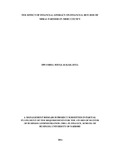| dc.description.abstract | Meru County has very high poverty levels and approximately 75% of the households live below the poverty line. The high poverty levels in the county raises questions on the financial literacy levels of the farmers apply and financial management techniques applied by the farmers in ensuring that they increase their financial returns from Miraa farming. This study examined the influence of financial literacy on the financial returns of Miraa farmers in Meru County.
Descriptive research design was adopted by the study. The target population constituted the Miraa farmers in Igembe, the main Miraa growing area. The study adopted descriptive survey technique. The data collected was analysed using SPSS version 21 and the significance of the results tested at 95% using ANOVA, and other statistical inference techniques like Z-tests, T-test and F-tests. The study found that financial literacy levels remained low among the Miraa farmers.
The financial returns from Miraa farming were also found to be as high as 160% of the capital invested. The linear regression analysis between the dependent variable which was financial returns and independent variables which were financial literacy, capital invested and size of the land showed a positive relationship between the dependent and independent variables. The results of the linear regression revealed an R of 0.8639 and R2 of 0.7463 indicating that there is a strong relationship between financial literacy, capital invested and size of land used in Miraa farming. P value was found to 0.0011 showing that the overall model was significant at 95% confidence. From the results, the study concluded that high levels of financial literacy, capital invested and size of land led to higher financial returns from Miraa farming. The study results were consistent with those of Lusardi and Mitchell (2011) who also found that financial literacy had significant effect on household income and locally to those of Mwambia (2011). The study recommends that; first, the county government to invest in instilling financial literacy knowledge to Miraa farmers through workshops and educating the farmers on how to increase their financial returns from Miraa farming as well as how to manage the money they make from Miraa farming. Secondly, the county government should come up with a financing program where Miraa farmers can be able to access cheap credit. This will provide them with the capital required to be invested and ensure that they maximise their financial returns. Finally, the farmers should be encouraged to farm Miraa in large scale so as to benefit from economies of scale | en_US |

